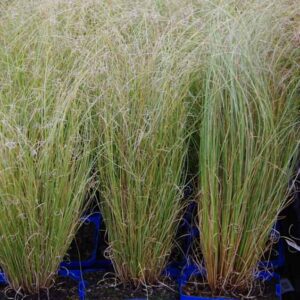Description
Carex testacea. Orange Sedge. Or known as Orange New Zealand Sedge is an ornamental grass-like plant appreciated for its striking coppery-orange foliage and its ability to add color and texture to various garden settings. Native to New Zealand, this evergreen perennial grass typically forms clumps and reaches a height of about 30 to 40 centimeters. Full sun-part shade in well drained soil.
Growing and Caring:
- Suitable Climate: Flourishes in temperate climates and is well-suited for gardens in coastal areas, demonstrating good tolerance to salt-laden winds and rosts.
- Sunlight: Thrives in full sun to partial shade, although it typically displays the most vibrant coloration when grown in full sun.
- Soil Requirements: Flourishes in well-draining, fertile soil.
- Watering: Requires regular watering, particularly during the establishment period, and benefits from maintaining a consistently moist but not waterlogged soil.
- Pruning: Trim back any dead or damaged foliage in the spring to promote new growth and maintain its attractive form and color.
- Nutrition: Apply a balanced fertilizer in the early spring to support healthy growth and maintain vibrant foliage color.
- Mulching: Apply a layer of organic mulch around the base to conserve soil moisture, regulate soil temperature, and inhibit weed growth.
- Pest and Diseases: Generally resilient to pests and diseases.
Attractive Features of Carex testacea for Landscaping:
- Striking Foliage Color: Carex testacea is celebrated for its striking coppery-orange foliage, providing an eye-catching focal point and adding warmth and vibrancy to garden borders and landscapes.
- Textural Contrast: Its fine, arching leaves create a captivating textural contrast when paired with other plants in garden beds or used as a ground cover, adding depth and interest to the landscape.
- Versatile Planting: Suitable for various garden styles, including contemporary, coastal, and Mediterranean-themed gardens, as well as in containers or as an edging plant in garden borders.
- Low Maintenance: Once established, Carex testacea requires minimal maintenance, making it an ideal choice for adding visual interest and color to low-maintenance landscapes and garden designs.
- Drought Tolerance: Known for its ability to withstand dry conditions, making it a suitable choice for water-wise gardening and sustainable landscaping in regions with limited water availability.
- Erosion Control: Its dense clumping habit makes it an excellent option for controlling erosion on slopes or embankments, contributing to soil stabilization and preventing soil runoff.




